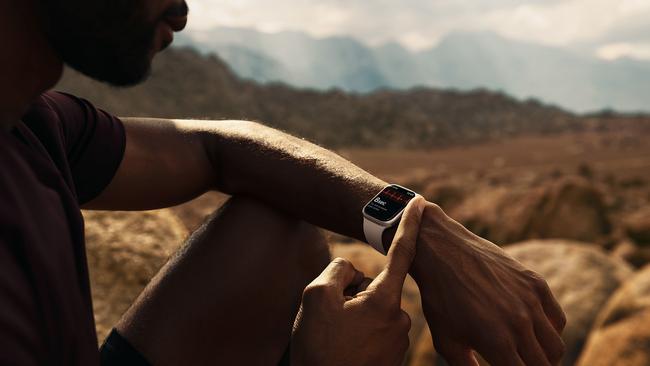Health smarts: how your smartwatch could help you recover from Covid-19
One sensor in your smartwatch could be the key to recovering from Covid-19 and seeking treatment when you need it.

SmartDaily
Don't miss out on the headlines from SmartDaily. Followed categories will be added to My News.
Could your smartwatch know you’re falling ill before you do?
And could that gadget be helpful when treating Covid-19?
These are questions being asked by medical research teams as smartwatch manufacturers partner with them to determine what role they can play in helping users during the pandemic.
But health experts say one sensor inside some of the top smartwatches could be a useful indicator of your lung health right now and is worth checking regularly to “know your baseline”.

That addition is an SpO2 sensor and it measures the oxygen level in your blood in a similar way to a pulse oximeter that might be placed on your finger in hospital.
The sensors work by beaming a red and infra-red light at your skin to determine your oxygen saturation, based on how much light is absorbed. A normal blood oxygen level usually sits between 95 and 100 per cent.
National public health service Health Direct recommends people suffering with Covid-19 monitor their oxygen levels for changes, particularly if they’re at high risk of complications.
While dedicated pulse oximeters are recommended for the task, medical experts say smartwatch sensors could provide a guide to declining health if one is not available.
Mater infectious diseases director Dr Paul Griffin says the feature in smartwatches could “potentially” be helpful to people suffering from Covid-19 infections, particularly if they could compare current blood oxygen results to their regular oxygen levels.
“We do have to remember that often the quality of the sensors in smartwatches is poor compared to devices for use in health care,” he says.

“Provided people do use them according to the instructions — they tend to be quite sensitive to movement — they could be useful.”
Dr Griffin says the use of oxygen monitors is particularly important soon after Covid is detected “so we can determine a decline relatively early” and treat patients where required.
Several smartwatch makers have also joined medical studies to determine whether their sensors could be useful in detecting and treating Covid-19.
Samsung, for example, partnered with Deakin University, the National Trauma Research Institute and SaniteX Global late in 2021 to launch a health monitoring system using its Galaxy Watch4.
Fitbit is working with Scripps Research to determine whether its data can detect Covid-19 infections early, and Whoop is asking users to participate in a study that would contribute their data to research if they test positive to the virus.
DEVICES THAT REGISTER EVERY BREATH YOU TAKE
Samsung Galaxy Watch4, Watch4 Classic (from $399):

Both of Samsung’s newest smartwatches offer a lot of health-tracking sensors, including one to measure blood oxygen levels. It kicks in when users sleep, monitoring oxygen levels throughout the night, though it can be used to take a measurement on demand. Results are plotted in Samsung’s Health app.
Apple Watch Series 7 (from $599):

The last two major Apple Watch releases have featured sensors that can assess a wearer’s blood oxygen level in just 15 seconds. Depending on its settings, the Watch can record oxygen levels periodically throughout the day and night, though users can also employ the app to check their levels. The data collected appears in Apple’s Health app.

This unusual fitness watch with no display tracks plenty of health information, including your blood oxygen saturation, your respiratory rate and your skin temperature; all of which play a role in determining your health and if you’ve contracted a virus. Each measurement is compared to normal range and shown in graphics within the Whoop app.

Fitbit calls this wearable gadget its “most advanced health smartwatch,” and its many health-tracking features include oxygen saturation monitoring which occurs as you sleep. The watch not only tracks how long and how well you snooze, but collects oxygen details and shows them in a graph so you can compare them over time and identify new trends.
Heart Sure Pulse Oximeter ($69): This dedicated pulse oximeter is designed just to measure your blood oxygen level and pulse rate, and uses a large, colour display to show both. The device can also sound alerts when levels are low, and it runs on two AAA batteries.





